NZ Logger Iron Test: Gen 4 Falcon Winch Assist
Driving through to Gisborne from Opotiki, several concerning things came to our attention.
The first was a loaded log truck heading away from the Port of Gisborne and towards the Port of Tauranga.
Apparently high port costs coupled with bad weather at the port – something loggers in this area have struggled with for years – make that extra 130km from Matawai worth it.
The other concerning thing was the height of flood debris on the fences before Te Karaka.
On the highway the flood waters have obviously been well above the roof of our 4WD D-Max, and then near the turn off to Mangatu Forest there are signs of the flood water being around seven metres deep – a colossal and dangerous, amount of water.
Many bridges are still out, and many roads are still either unpassable to log trucks or are barely more than goat tracks, so they are slow and expensive to cart logs on.
With costs so high and the earning window restricted by the weather, Gisborne-based crews like A & R Logging are looking to new technologies like the Falcon 2-speed winch to make their operations faster, more resilient and more efficient.
Manufacturers comments
Falcon’s Winch Assist 2-speed Project Manager, Shaun Mills, says the concept was very much customer-driven at the instigation of another Gisborne logger, Blake Speirs:
“We collaborated with Blake and Tigercat on this development and Blake has pretty much been running this skidder set-up since about 2018.”
Presumably as a result of this collaboration, Tigercat went ahead and made front-facing winch mounts and tether holes in the blade as factory standard. So that tells you they saw the writing on the wall.
Thinking about clearing of possible driftwood from creeks, the skidder on a tether probably has quite a lot of potential too.
Blake was not available to talk – and given the atrocious state of Gisborne infrastructure, it’s not surprising that he is short of time – but our new Iron Tester for Gisborne, Tony Hill says Blake has “a massive tethering operation going on” a little further north of A & R Logging’s operation.
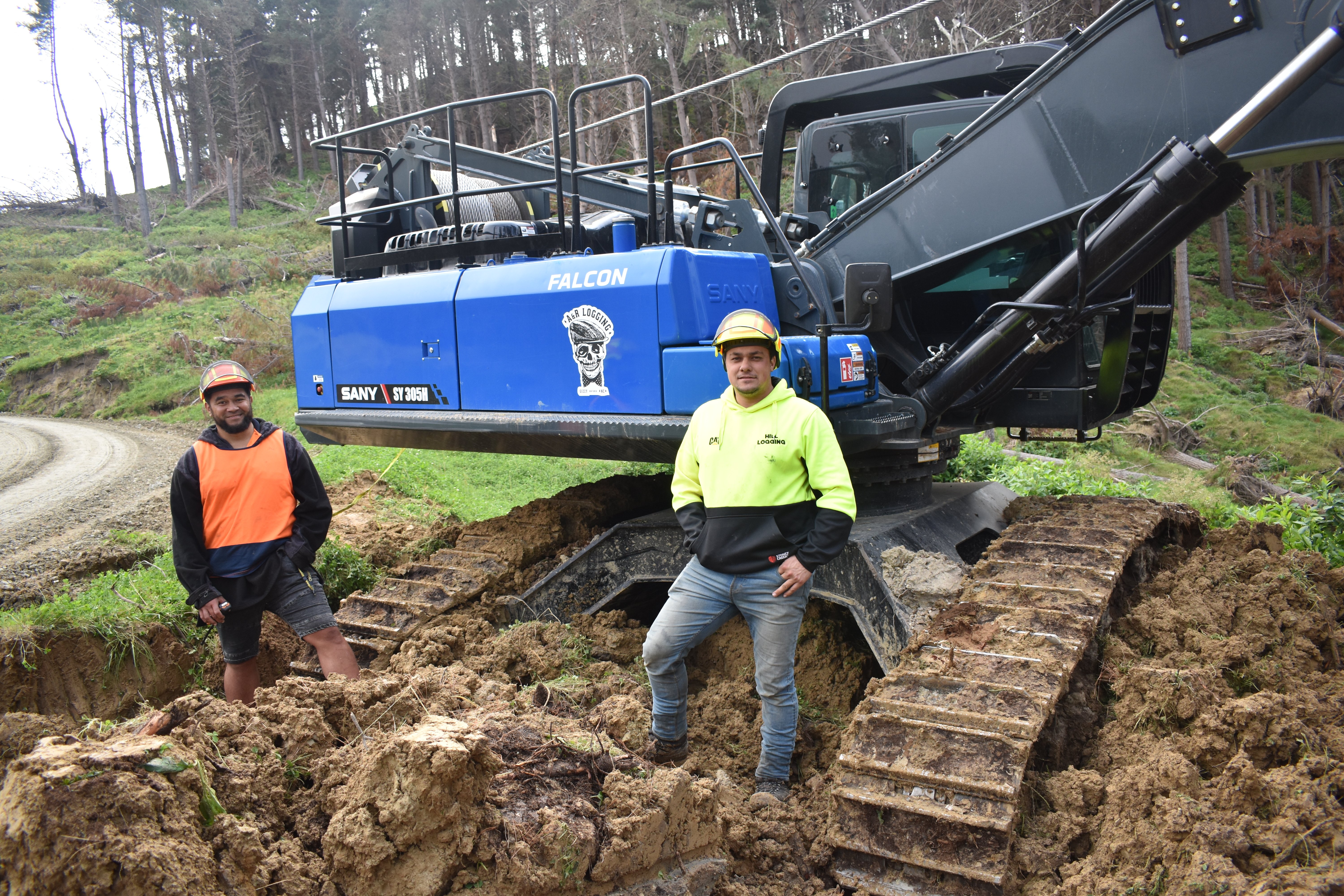
Logging’s in the blood
Logging wasn’t the first plan in life for Arana Kuru of A & R Logging.
Although he did a bit of it in his teens because a lot of his family were into it (Dad, Jack and brother Ricky), Arana went off to Europe for 10 years – a few of those spent filleting and packing fish and doing groundwork for property developers, among other adventures, before returning to New Zealand.
He studied civil engineering project management and then went to work in that field in Auckland.
“I soon figured out that Auckland was a place I never wanted to raise my kids. I hated Auckland,” Arana says.
“I was prowling around looking for something different when I heard a crew was for sale back home here in Gizzy.
Me and Dad went and saw Bob Rye of Rye Logging, the crew owner, and I got finance from UDC. We were into it. I never thought I’d be doing this stuff for a living, but here we are.”
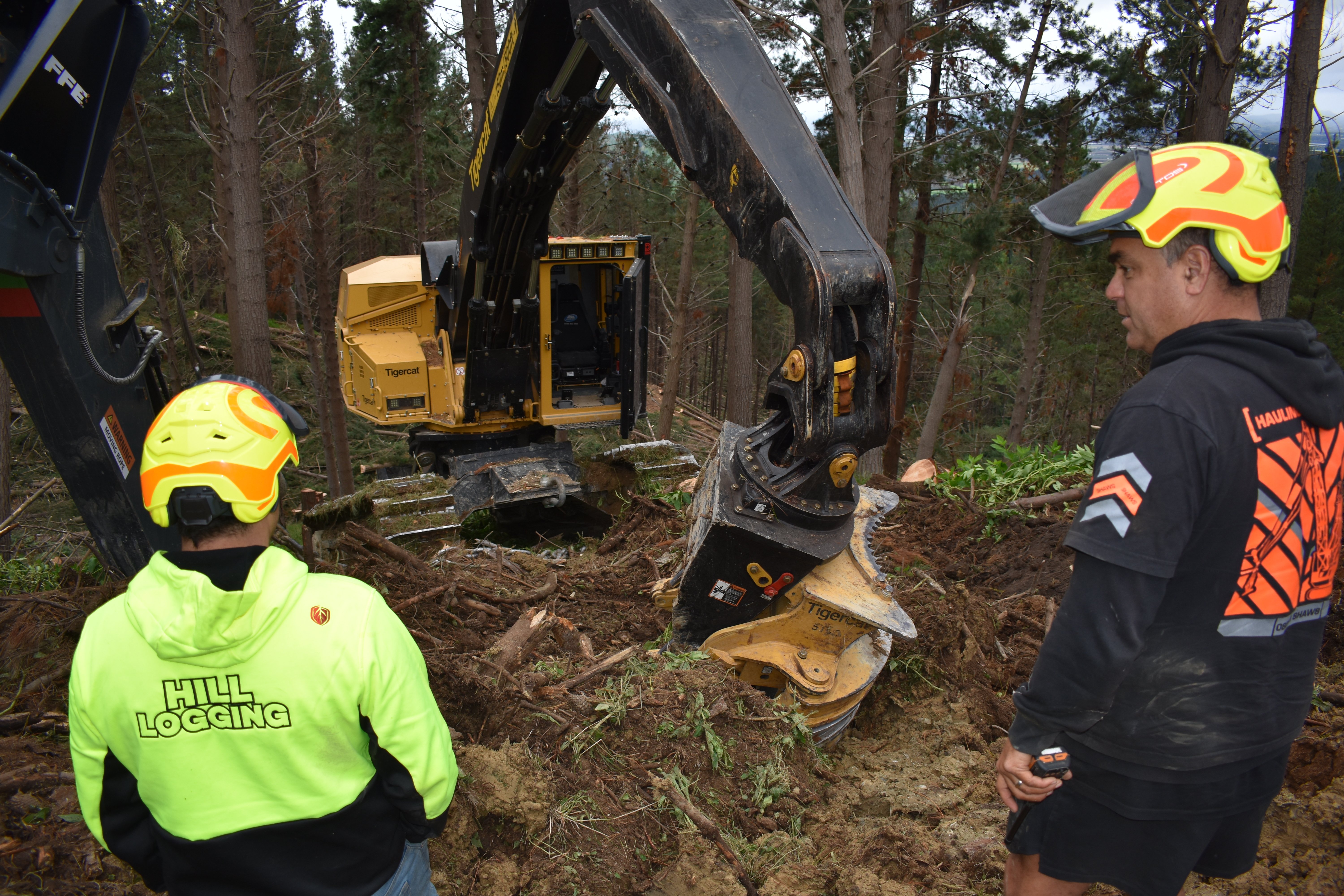
Starting the day with a tailgate meeting
After some paperwork at Arana’s container, the Iron Test team follows the Madill swing yarder up the road.
It has made good time up the hill and is already on the new landing with some huge piles of shovelled stems ready to be fed into the grapple about 100 metres away down in the broken ground. It’s mostly papa around here.
Some short, steep pinches but generally moderately steep slopes with tall straight trees wherever the wind hasn’t gotten into them.
A manual faller (Hamish Campbell, aka Ma Dredd) is making good progress up beyond the Falcon Winch Assist and its tethered 855.
The steady barp-barp of the chainsaw followed by the thump of trees hitting the ground is a good background to the discussion about tethers.
Arana says the ground that is worked by the tethered machine is really only limited by your mind rather than the machine.
“I challenge myself a fair bit on it and think it’s amazing where it will allow me to operate, and then I will have a wander through some ground harvested by the other guys and you just ask yourself, how the hell was this achieved?
And then I realise how much more capability I have to acquire.
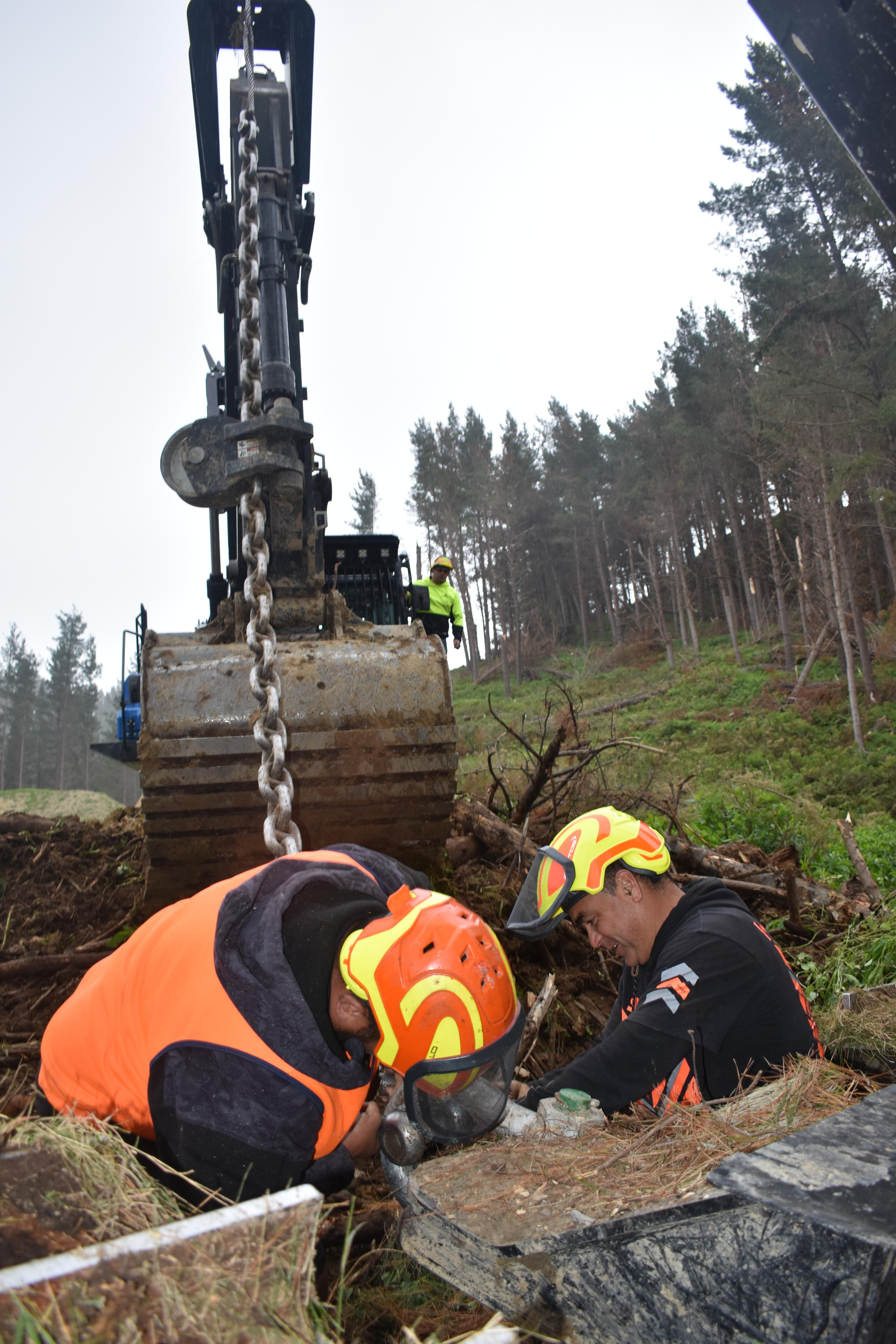
Tether capability
I am surprised by some of the situations the tether has assisted me out of while down the hill felling actually.
In most situations I find myself being the element that restricts its abilities rather than the machine itself.”
Expanding the capability was also part of the reason why Arana bought the new Sany based Gen 4 Falcon Winch Assist in August 2022.
The previous Hitachi-based Falcon is with his tower crew running a Madill 171.
The new machine has done a bit over 500 hours in that time and so far, has impressed with its increased strength and stability – much needed attributes in what has so far been a rocky year.
So what does Arana think of the Sany based Falcon Winch Assist?
“Pretty mean. It’s grunty compared to the old one. It runs like a nice smooth 30-tonne digger. High and wide. Heaps of grunt. No ad blue. Straight 6 Isuzu. It’s basic and that’s all I wanted, apart from digging the odd deadman it just sits on the ridge and idles most of the time. And when you want to move it, the thing just tears it up. Massive track power. I’m happy as with it so far.”
%20Wild%20Hog%20Logging%20Falcon%20Winch%20Assist%20With%20Tigercat%20Skidder%20and%20Felling%20Machines%2000-01-57.jpeg?width=618&height=259&name=(1)%20Wild%20Hog%20Logging%20Falcon%20Winch%20Assist%20With%20Tigercat%20Skidder%20and%20Felling%20Machines%2000-01-57.jpeg)
Steep slope tethered skidders
The intention was to match this unit with a skidder (Tigercat 635H) in A & R’s roadline crew when required, and generally float between the three crews as required.
That roadlining crew also has a felling machine (Caterpillar 552 series 2) working full time.
So what does a new Falcon Winch Assist cost these days?
It depends on the base machine and the extras that are added to the build, however DC Equipment, the manufacturers of the Falcon brand, work with customers to make sure it fits with their requirements.
Loggers have a wide range of base machines they can choose from to ensure it fits in with their operational needs and maintains the current relationships they have with service providers.
“One of the problems we have,” Arana says, “is it’s either summer so we don’t need a tethered skidder or it’s just too wet to work at all.
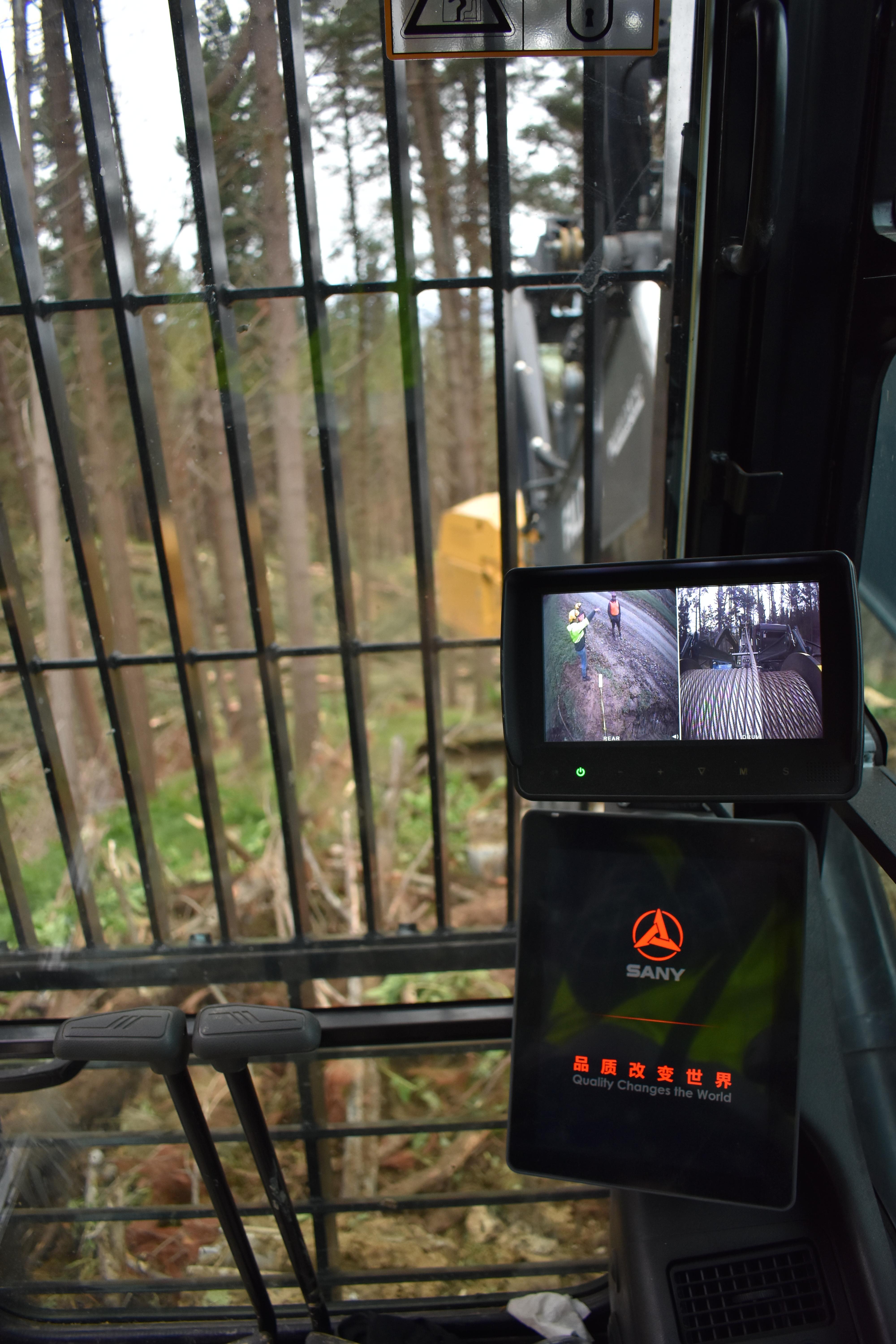
Road lining
The road lining crew often encounters little triangles that would be more efficient for this tethered skidder set up, and the original plan was we would do those triangles but as there have been a few setbacks with the port, the roads, the windthrow and the markets, plans have had to change and its basically in a holding pattern.
At the moment our road lining crew are just confined to corridors and they are outstripping the road builders as they only have a 40-tonne digger and a bulldozer and they aren’t able to keep up with us.”
The higher-speed gear is way too quick for the felling machine so as yet, second gear on A & R’s machine is still brand spanking new and rearing to go.
Across the Valley there's another Falcon
We catch up on the phone briefly with Josh Williams over at Wild Hog Logging an hour or so north who has tried out the Falcon in second gear.
“It’s a game changer,” says Josh,
“Probably 25% of our tether time is using the six wheeled skidder. We require less logging tracks because of it, so there’s way lower disturbance of the environment.
We can do bigger drags with the enhanced traction and consequently we can drag from further away and still make it viable. In a way you could say it gives us the capability of a small hauler crew.
Our felling machine will shovel onto a ridge and then we send the skidder down the rope for the bunches.”
“We also had a traction issue in the wet on flat to moderate slopes and as soon as we put the tether on it, all the wheel spin stopped, so you’re expanding your weather window and not disturbing the soil anywhere near as much. We will still stop when it gets too wet though as this soil on the coast tends to get a bit messy when it’s really wet.”

Back on the ground
Back at A & R Logging we discuss what it’s like for Arana going from no tether to tethered back in 2017 when he was the first on the coast to get a Falcon tether:
“The obvious major difference is you end up manual cutting more of the setting with no tether, as you are unaware of where you can get to on an untethered machine. You don’t want to open up a piece only to find you can’t get back in there and have to send the manual faller into a dangerous situation.”
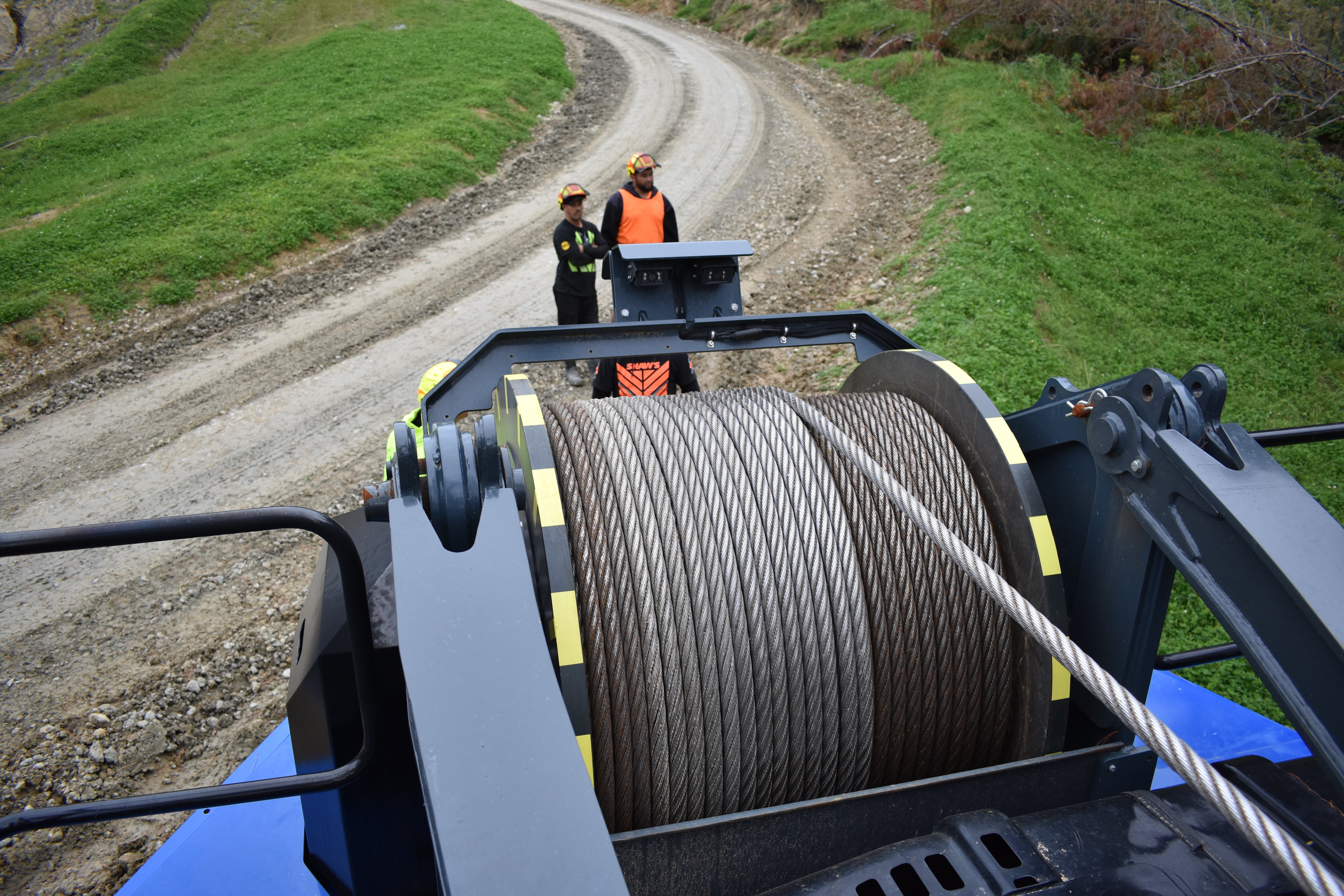
Tether 101
So what’s it actually like running one of these tethered machines?
“The tether control screen is fixed in the top corner of our Tigercat’s cab where it can be easily viewed,” Arana says.
“The control buttons are on the joystick and are easy to access and use. By pushing a button, you can turn the winch mode on or off, increase or decrease the desired rope tension, manually pay rope in or out and it has an emergency winch stop.
Very easy to use and accessed with one thumb.
“It’s also easy with just the one rope to think about. The Falcon Winch Assist system ramps up the revs and picks up the rope slack as you move around the hill, which minimises the chance of walking over it and it also feels more stable as the tether pulls the carriage frame into the ground.
“Before the tether, the machine felt stable, but you would always be aware of the changing weather. I was often walking the machine out to the entry point if the rain was setting in. Now, with the rope, that is not a question as I know I can safely get out.”
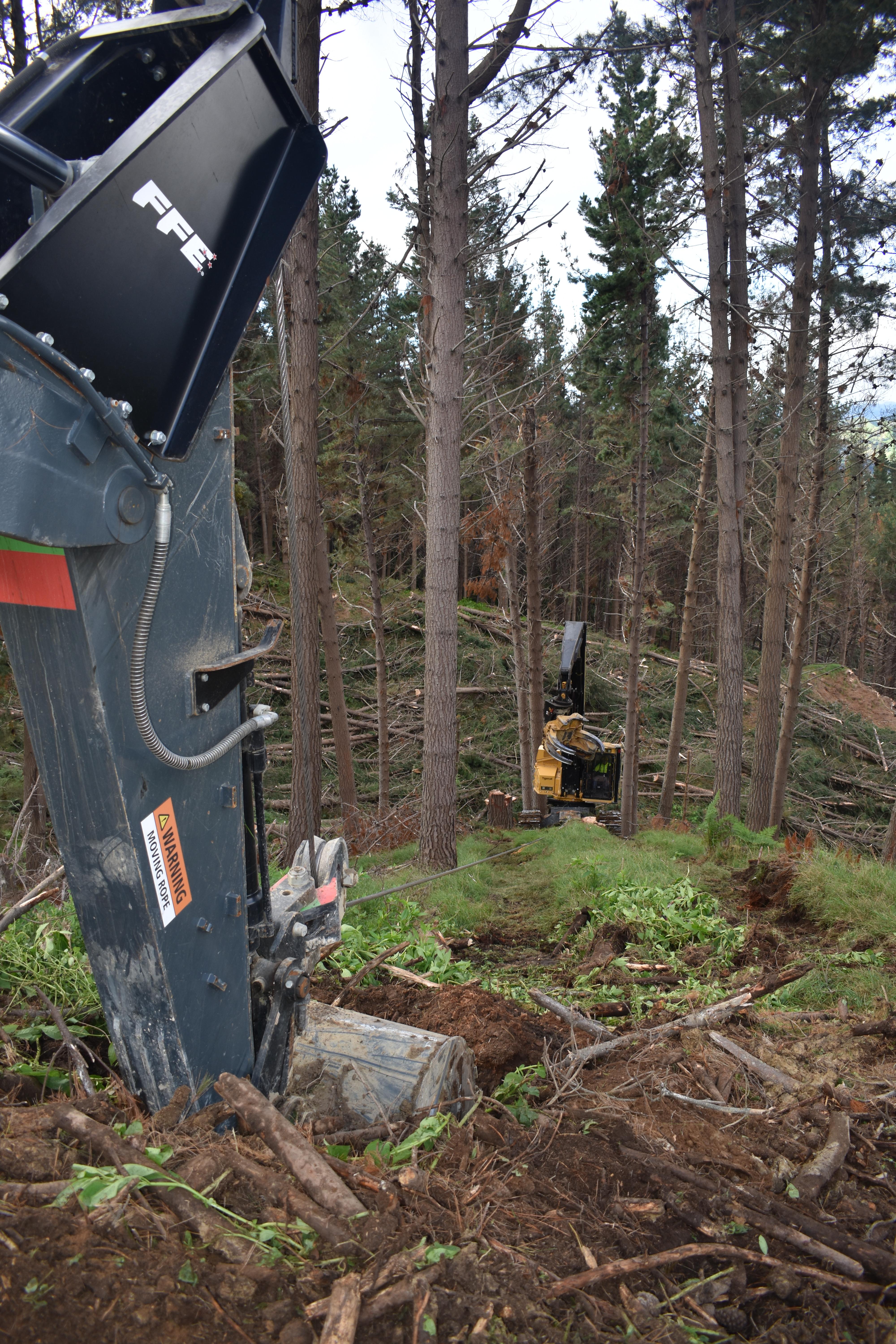
Binding and block management
So how often does Arana bind around stumps (side washing)?
“I try to avoid it as it uses some of the available assisting force. When a felling face has a top leading ridge that is too narrow to fit the tether and felling machine on, I will point the tether parallel to the ridge, bind on a stump and fell down the hill perpendicular to the stump.”
“This allows me to fell a strip from top to bottom. Once the strip is felled, I flick the rope off the stump and onto the next one and follow this process working my way back to the winch machine.”
Hanging on a rope on steep slopes seems pretty risky, so what does Arana look for in an operator when selecting someone to run a tethered machine, apart from big cojones and big brains?
“You really want a person that has great communication skills, has a sound process to evaluate a situation that assists them in decision-making. And someone who works well in a team environment.”
“Communication is essential when planning the setting before felling starts, to avoid unsafe practices down the line. You want a person who knows how to make the right call after weighing up the options and someone who has shown a solid history of that in the crew.”
The other regular operator (when Arana isn’t running it) is Maka and he says the set-up is way more comfortable after moving into the new Falcon/Sany/Tigercat combo.
“The controls are quite easy. You can spend all day working it and still come out feeling fresh.”
Maka has been in this crew a bit over 10 years, having started with the previous owner up in Coromandel and then moving down here before Arana bought it.
“I started off on the skids and then into breaking out, then slowly started getting into the machines.”
It’s fair to say that steady progression has led to what is arguably the pinnacle of forestry machine operation with Maka running a purpose-built harvester down on the latest model tether machine.
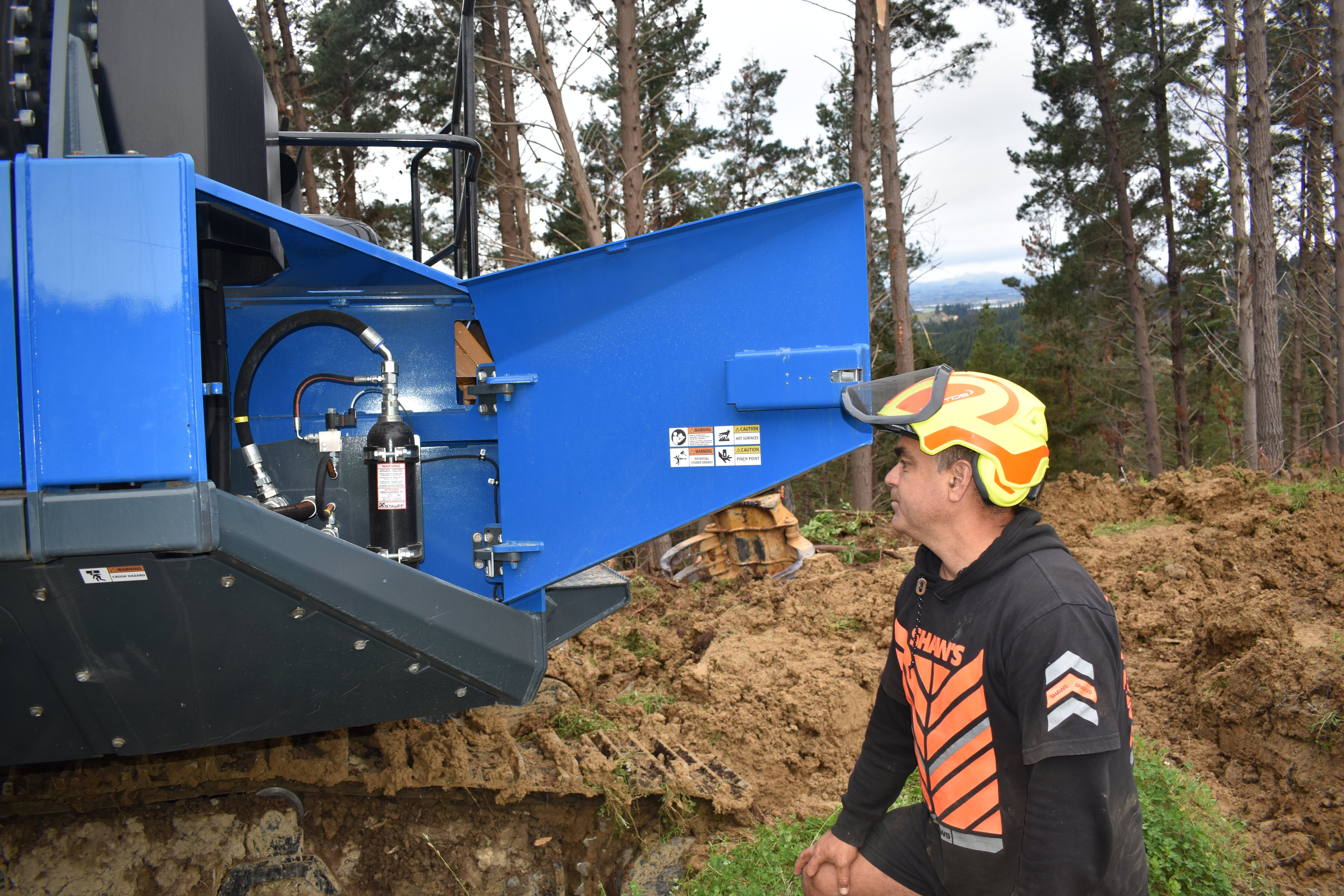
Compact winch fits on more bases
DC Equipment’s Design Manager, Darin Borcovsky, says the Gen 4 introduced a suite of changes to the previous versions including a swept up rear end, interface upgrades and a generic version unit to fit on any 30-tonne weight class machine.
In addition, DC Equipment Marketing Manager, Tom Filmer, says,
“It’s giving contractors more agility for the equipment in their business. If needed, contractors can re-purpose suitable second-hand base machines which helps with costs, especially at a time where there’s a range of challenges within the industry. Combined with more use-applications for the winch such as using for ground base skidders, it’s providing additional value across a diverse range of logging operations.”
Market forces & significant weather events
Landing on your feet in a downturn following a devastating cyclone is a pretty cool skill to have gained.
That’s a team effort here with A & R Logging being placed by Forest Management New Zealand (FMNZ) in a forest just 15 minutes from Gisborne to keep crew travel and log transport costs super low, with an on-site rock quarry to further lower costs.
With 4000 tonnes of logs left on the skids at a previous block due to road closures caused by Cyclone Gabrielle at Putere (Wairoa) when the Iron Test team visited Gisborne, it’s pretty astounding to hear A & R also have about 1000 tonnes on the skids on this new block that couldn’t get into the local Gisborne port due to lack of space last month.
And as Arana says, “They don’t pay on stocks.” “We were actually told about a week ago we might have our month’s target in stocks which is a bit alarming to hear mid-month.
Then we found an ugly little triangle that we could do, that took three days, and then we got this uncapped windthrow deal.
And just looking around we are pretty sure there is another couple of hectares of windthrow we can get to, so bit by bit we are getting work through the month.
It’s just trying to keep everybody busy, it’s just horrible times at the moment.
For the next month all three crews will be operating but under supervised harvest caps,” Arana says.
“It will be enough to cover costs but not help claw back the losses from the last four months.”
That 4000 tonnes is finally on the move with the highway to Napier log port now open so that should finally give the cashflow a much needed jolt in the right direction next month.
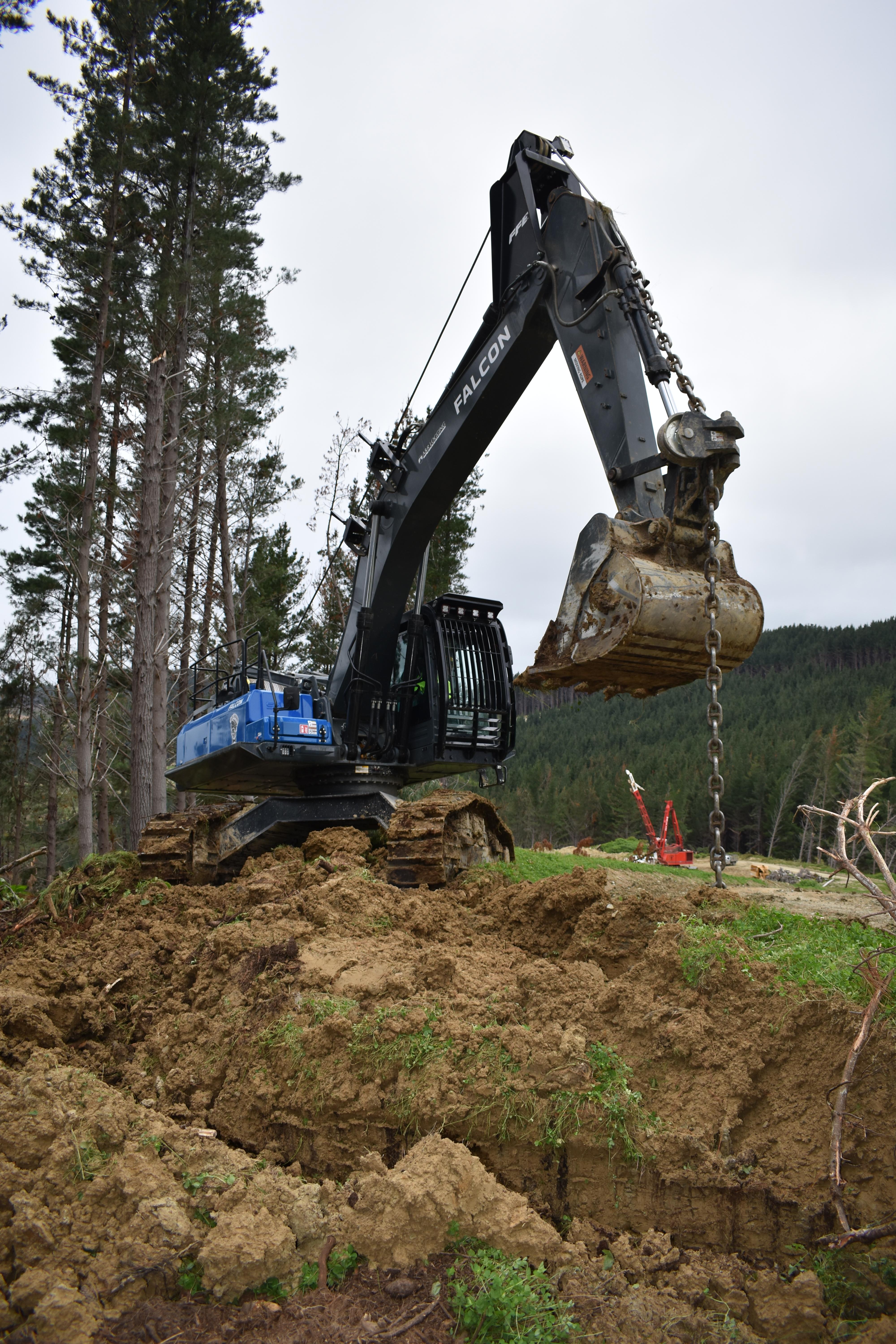
Iron Test insights
Our Iron Tester, Tony, is logging just over the ridge in the same forest but managed by Summit and Tony reports that they are still uncapped and will likely hit 10,000 tonnes this month as Summit has long term secured markets.
At A & R, Tony climbs into the Sany/ Falcon and moves it into position ready to connect the chains up to the 855, digging the rock bucket into solid ground and adjusting the rope so it is ready to connect.
It’s not the normal scheme of things to be running two machines in an Iron Test but in this context we are essentially testing the whole system.
Tony has spent a bit of time on several other tether systems.
“The advantages of the Falcon Winch Assists are that they are versatile; you can easily use them to load a truck or dig deadmen in. The Falcon is a weighted clutch system, so it’s smoother than some other systems.”
Tony heads down the slope on the tether and you can read about his test on the next page.
As he climbs back up the slope to the road, the rope tension monitor shows 17 tonnes on a steep pinch as Tony climbs over a stump but the base is completely unaffected.
Other partners in the set up include PFS Engineering providing the ROPS for the Sany and Duxson providing the cab protection upright bar for the Tigercat.
I have been looking forward to seeing what this latest Falcon Winch Assist Sany-based machine is like after spending a fair bit of time running the previous model.
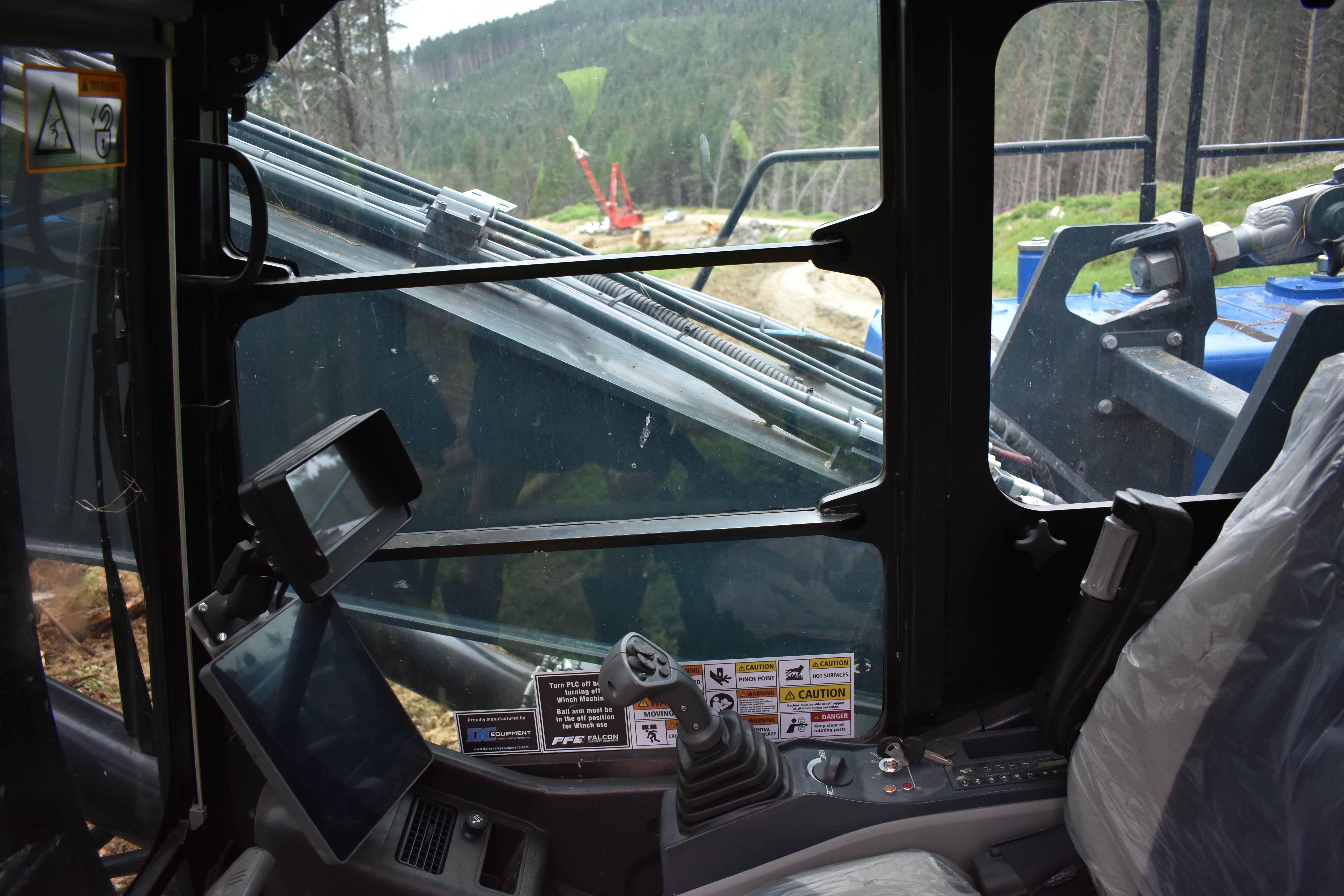
First impressions
First impressions of this machine are that it is robust and well made – pretty important aspects if you’re going to be down a steep slope on the end of a rope. Nice high and wide undercarriage.
The cab is easy to climb into with the extra step off the catwalk.
Falcon has kept the design simple, reliable and compact which is surprising given it now has more capabilities.
I usually run an earlier model single speed Falcon Winch Assist mounted on a Sany 305 with a Cat 552 leveller down the tether. The Cat has more ground clearance than this Tigercat here but the reach on this machine is good.
The controls are Falcon’s tried and trusted set up which is easy to get used to even though it’s in a different machine.
My first introduction to tethers was watching and learning about a Trinder type tether system and about six years ago I got a Falcon Winch Assist on an SH300.
I’ve also run an EMS system off and on for the last four years or so.
The regular rock bucket on this machine is a good choice; you’ll be able to track through all types of rock and dig nice tidy slots for burying deadmen for the hauler.
The bucket controls are smooth, accurate and powerful, as well as being exactly where you’d expect them to be.
It’s got a good standard reach and the balance is okay. It has very good side-on stability which is probably why they’ve gone high and wide.
It can be a bit of an issue if all your gear is high and wide except your winch machine and then you want to send it somewhere challenging. You’ll probably get there but not without a bit of stress that it might tip over.
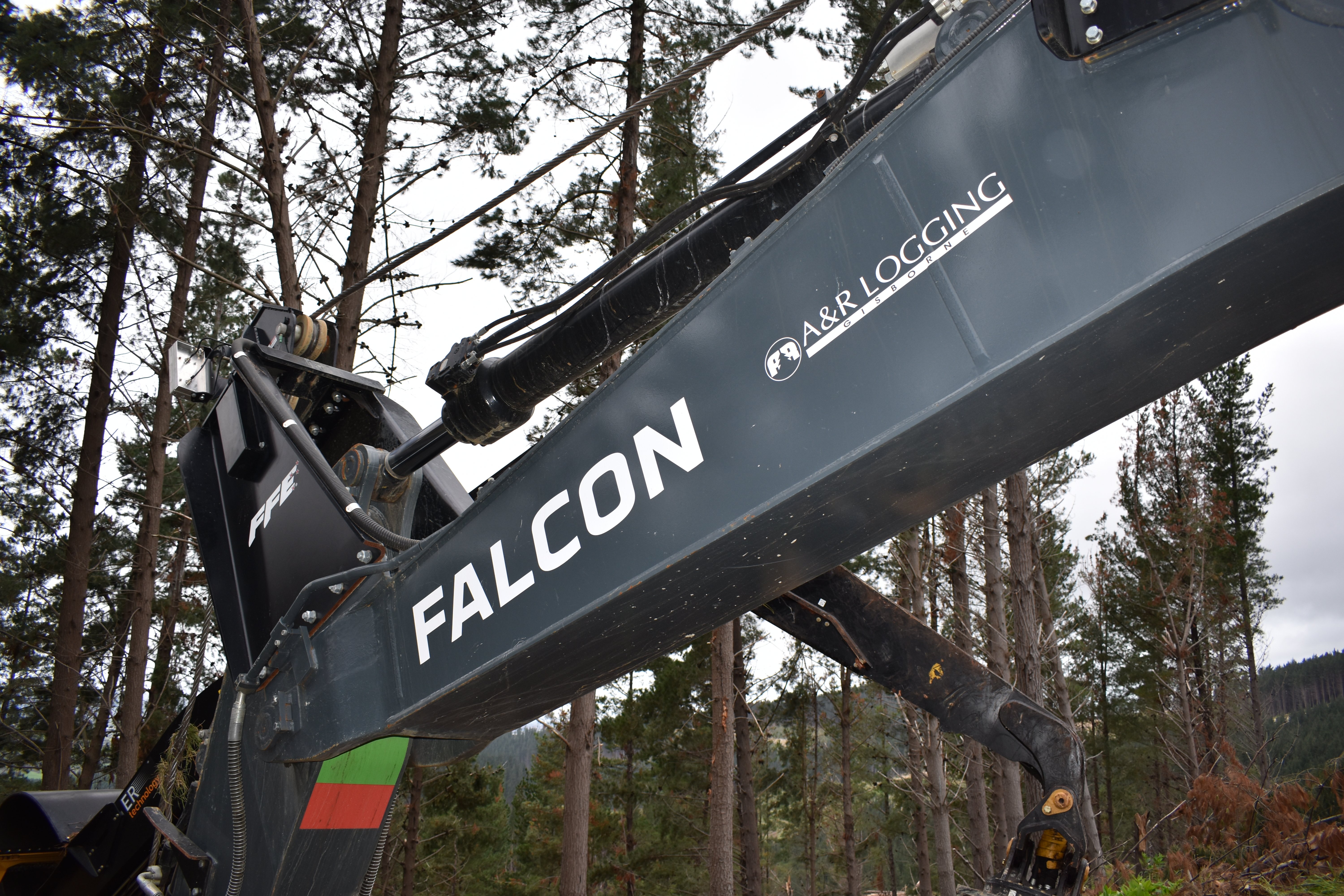
Incomparable
Walking-wise the Sany is like a 20-tonner on steroids, very fast and powerful.
They could actually button that back a bit but I guess we can just turn the revs down a tad so it’s not so aggressive going up steep areas. Far better to have some power in reserve than be wanting more.
No RT in this machine but we are all carrying handhelds today so that’s not an issue.
Climbing out of the Sany and into the Tigercat to head down the slope tethered, I had to call up a few times to clarify the Tigercat felling head controls with Arana and Maka and that was sorted clearly on the handheld.
I like that felling head too, it works well. The cameras are nice and clear and well placed. The view of the drum in particular is very good.
You want to be sure in that department and Falcon has provided that clarity of what’s going on with the winch.
I am looking forward to using one of these to run a skidder down the tether when circumstances allow, that’s for sure.
For a tether machine this is more than enough, while at the same time not over -capitalising with a more expensive base brand.
I’d be happy to run one of these on a daily basis.
Words by Tim Benseman; published with permission by NZ Logger Magazine
Share this
You May Also Like
These Related Stories

A tip to keep yarders standing

Logging Legend: Cable Logging
